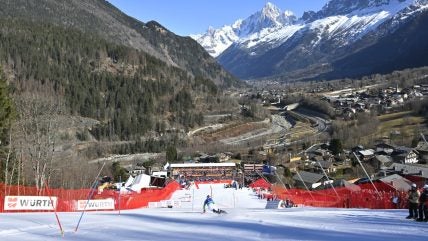
Climate change has been present for some time and is especially a hot topic of conversation for winter sports that rely on cold weather and snow. However, in what has been called “the most extreme event ever seen in European climatology,” January temperatures reached historic highs in multiple countries across Europe.
In essence, ski resorts in Europe experienced spring temperatures in January. During the new year, which is a hectic period for holidaymakers to ski, many resorts experienced strips of white cascading through fields of green.
According to a recent report from the Institute for Snow and Avalance Research, a green Christmas in the Alps is about to become increasingly common. Over the New Year’s weekend, Switzerland recorded its highest-ever January temperature north of the Alps with thermometers hitting 20.2 degrees Celsius in the town of Delemont.
What does this mean for ski racing?
Fortunately, for alpine ski racers, artificial snow is a preferred method for course preparation by the International Ski Federation (FIS), as it allows race crews to create a hard icy surface that can withstand long start lists and stimulate fair conditions for as many athletes as possible.
Even though artificial snow may be a preferred choice for racers and race organizers, it is an expensive method of generating snow and has its downfalls, including temperatures being too warm even to make artificial snow.
How well do you really know your competitors?
Access the most comprehensive Company Profiles on the market, powered by GlobalData. Save hours of research. Gain competitive edge.

Thank you!
Your download email will arrive shortly
Not ready to buy yet? Download a free sample
We are confident about the unique quality of our Company Profiles. However, we want you to make the most beneficial decision for your business, so we offer a free sample that you can download by submitting the below form
By GlobalDataMaking snow is not a cheap undertaking. Ski areas spend anywhere from $500,000 to over $3.5 million per season to do so. Nevertheless, the biggest costs for snowmakers are energy and equipment.
The big energy consumers in the operation of producing artificial snow are water pumps and air compressors. Water pumps push water from rivers or holding ponds up the mountain to the guns, and air compressors pressurize air, which is mixed with water and ejected onto the slopes.
Up until a few years ago, the beginning of the winter season was guaranteed a base layer of fresh snow. However, this is disappearing and there is more of a reliance on the snow cannons generating snow.
Artificial snow is not a new sighting for winter sports.
The 2022 edition of the Winter Olympics, held in Beijing, was solely reliant on artificial snow. China estimated that the snowmaking would require 49 million gallons of water, which was highlighted as a risk by the International Olympic Committee’s (IOC) evaluation during the bidding process. The Beijing Olympics was not the first winter games to use fake snow and will not be the last.
The economic consequences of climate change are having a huge impact on ski resorts. The ski seasons have been getting shorter and resorts are having to invest in expensive snowmaking equipment to ensure sufficient snow coverage.
Additionally, when resorts are forced to close earlier than expected due to a lack of snow, it can lead to lost revenue and job losses. Winter sports are very popular in European countries like Austria and Switzerland.
If a resort is losing revenue due to having to close early, they may not feel it’s possible to commit to hosting a World Cup race. Ultimately, winter tourism in ski resorts could, and probably will be, heavily affected.
It has been 100 years since Chamonix hosted the first Winter Olympics in 1924, but research by the IOC last year found that only 10 countries will be able to host snow sports by 2040 due to the impact of climate change.
In terms of the Alpine skiing World Cup, races are being either re-scheduled or canceled due to a lack of snow and unseasonably warm conditions. Not even the snow canons can always mask climate change.
A portion of a ski resort’s revenue will come from the ski race attraction when a resort is hosting a race. However, if resorts are unable to produce artificial snow and races are canceled, major tourism revenue will be lost. Not only is this disappointing for fans, organizers, and the racers, but it’s also a major loss for the resort’s revenue.
As mentioned, fake snow comes at a cost, it is both water and energy-intensive. This has led La Molina in Italy to dedicate spending the next three years testing a new snowmaking technique that promises to be far less resource intensive, as well as being able to produce snow at warmer temperatures.
This would, if effective, resolve the recent issues of canceling World Cup races due to lack of snow and high temperatures. Resorts are keen to plot for a warmer future, as they not only want to keep winter tourism alive but also keep ski racing a popular and successful sport.
It is evidently not possible to avoid the effects of climate change which are already having huge impacts on ski resorts. Therefore, adaptation is necessary but expensive. As has been said, creating artificial snow does not come cheap.
As for ski racing, it can only be kept running in the long term with artificial snow. Yes, years will vary in terms of which time of the season there will be lots of snow and when there will not, however, for all races during the year to go ahead, artificial snow that can still be made in warmer temperatures is going to be vital in years to come.
Ski resorts must be able to remain open for as long as possible, both to maintain generating revenue but also to keep ski racing on the calendar.
(Photo by Alain Grosclaude/Agence Zoom/Getty Images)







